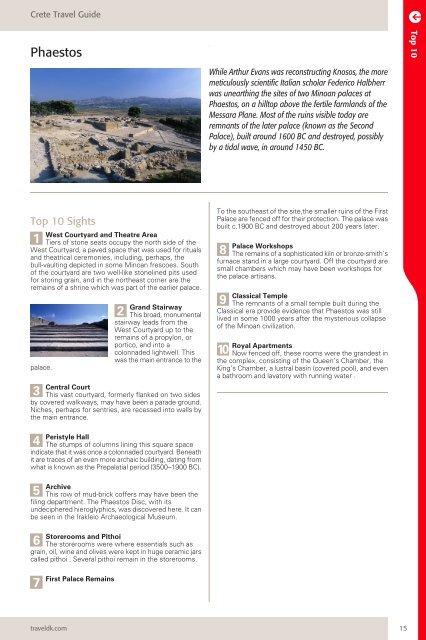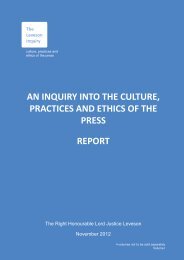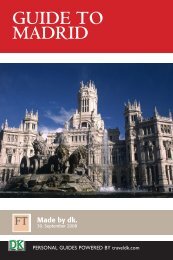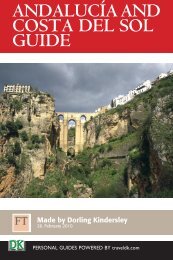CRETE TRAVEL GUIDE
CRETE TRAVEL GUIDE
CRETE TRAVEL GUIDE
Create successful ePaper yourself
Turn your PDF publications into a flip-book with our unique Google optimized e-Paper software.
Crete Travel Guide<br />
Phaestos<br />
Top 10 Sights<br />
1<br />
West Courtyard and Theatre Area<br />
Tiers of stone seats occupy the north side of the<br />
West Courtyard, a paved space that was used for rituals<br />
and theatrical ceremonies, including, perhaps, the<br />
bull-vaulting depicted in some Minoan frescoes. South<br />
of the courtyard are two well-like stonelined pits used<br />
for storing grain, and in the northeast corner are the<br />
remains of a shrine which was part of the earlier palace.<br />
palace.<br />
3<br />
2<br />
Grand Stairway<br />
This broad, monumental<br />
stairway leads from the<br />
West Courtyard up to the<br />
remains of a propylon, or<br />
portico, and into a<br />
colonnaded lightwell. This<br />
was the main entrance to the<br />
Central Court<br />
This vast courtyard, formerly flanked on two sides<br />
by covered walkways, may have been a parade ground.<br />
Niches, perhaps for sentries, are recessed into walls by<br />
the main entrance.<br />
4<br />
Peristyle Hall<br />
The stumps of columns lining this square space<br />
indicate that it was once a colonnaded courtyard. Beneath<br />
it are traces of an even more archaic building, dating from<br />
what is known as the Prepalatial period (3500–1900 BC).<br />
5 Archive<br />
This row of mud-brick coffers may have been the<br />
filing department. The Phaestos Disc, with its<br />
undeciphered hieroglyphics, was discovered here. It can<br />
be seen in the Irakleio Archaeological Museum.<br />
6<br />
Storerooms and Pithoi<br />
The storerooms were where essentials such as<br />
grain, oil, wine and olives were kept in huge ceramic jars<br />
called pithoi . Several pithoi remain in the storerooms.<br />
7<br />
First Palace Remains<br />
traveldk.com<br />
While Arthur Evans was reconstructing Knosos, the more<br />
meticulously scientific Italian scholar Federico Halbherr<br />
was unearthing the sites of two Minoan palaces at<br />
Phaestos, on a hilltop above the fertile farmlands of the<br />
Messara Plane. Most of the ruins visible today are<br />
remnants of the later palace (known as the Second<br />
Palace), built around 1600 BC and destroyed, possibly<br />
by a tidal wave, in around 1450 BC.<br />
To the southeast of the site,the smaller ruins of the First<br />
Palace are fenced off for their protection. The palace was<br />
built c.1900 BC and destroyed about 200 years later.<br />
8<br />
Palace Workshops<br />
The remains of a sophisticated kiln or bronze-smith’s<br />
furnace stand in a large courtyard. Off the courtyard are<br />
small chambers which may have been workshops for<br />
the palace artisans.<br />
9<br />
Classical Temple<br />
The remnants of a small temple built during the<br />
Classical era provide evidence that Phaestos was still<br />
lived in some 1000 years after the mysterious collapse<br />
of the Minoan civilization.<br />
10<br />
Royal Apartments<br />
Now fenced off, these rooms were the grandest in<br />
the complex, consisting of the Queen’s Chamber, the<br />
King’s Chamber, a lustral basin (covered pool), and even<br />
a bathroom and lavatory with running water .<br />
15<br />
Top 10
















